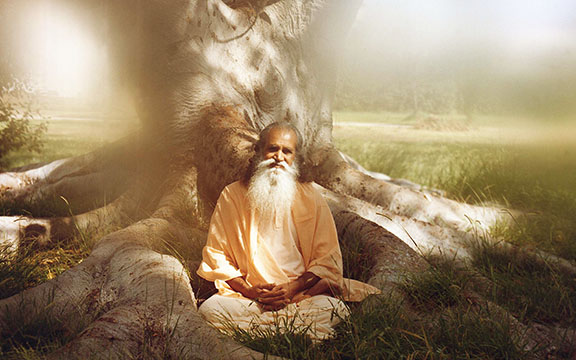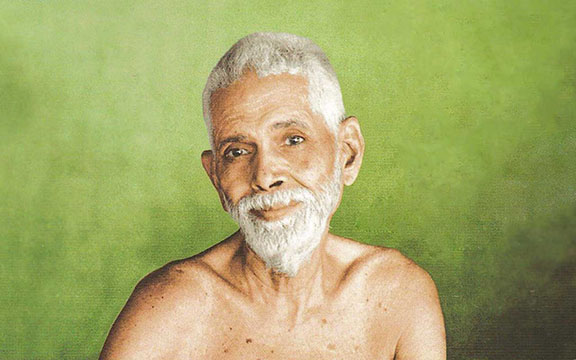 Through venerating our Guru, our lineage and traditions, we are connecting with the principle of Guru-tattva. This is summarized in Śrīgurustotram: akhaṇḍamaṇḍalākāraṁ vyāptaṁ yena carācaram tatpadaṁ darśitaṁ yena tasmai śrīgurave namaḥ
Through venerating our Guru, our lineage and traditions, we are connecting with the principle of Guru-tattva. This is summarized in Śrīgurustotram: akhaṇḍamaṇḍalākāraṁ vyāptaṁ yena carācaram tatpadaṁ darśitaṁ yena tasmai śrīgurave namaḥ
Salutations to that Guru, who has shown to me That undivided Whole, by which is pervaded all that which moves and that which does not move.That power of Consciousness that makes all this possible and this seeing possible, gratitude to that Guru.
This is Guru-tattva. The Guru principle points to the level of transmission—the teachings and practices—coming through anyone or anything. And in the Vedic and Yogic traditions, this level stands apart from personality, human foibles, and so on. So, the tradition is encouraging us to open completely to the tradition’s teachings and practices.
Today, there is a lot of misinformation and misunderstanding about the nature of the Guru. There have also been many problems and abuses that have occurred within this tradition in modern times, with some living teachers. So, we especially need to be clear that the classical tradition of Guru-tattva does not talk about putting one’s complete trust in “a human being” as in the interpersonal level (human being to human being). The Guru is in the role of being a luminous beacon of transmission of a tradition and its teachings. We are venerating the transmission of a tradition, not a human being.
“The syllable gu means shadows. The syllable ru, he who disperses them.
Because of the power to disperse darkness, the Guru is thus named.”
—Shukla Yajur Veda, Advayataraka Upanishad 16.
Guru-Disciple: A Symbolic Relationship
Since the 1960s, we have seen the influx and influence of many Gurus bringing a variety of teachings to the West and into a culture that was, in many ways, wholly unprepared to understand this. Some students began to blindly follow a Guru, while others when they heard the word “guru,” equated this term with a cult. All of these distortions can happen, not only in the Yoga tradition, but in other traditions, like in the Buddhist tradition, with its own practice of Guru Yoga. There are many ways in which we can misunderstand Guru-tattva. For example, this principle can lead us to misunderstand it as some weird type of power dynamic in which we let go of our own innate wisdom and sanity and give that away to some other person, group, or organization. This is not a correct understanding of the tradition, which in fact points to—in its fullest sense—helping us get in touch with our inner wisdom.
In the Integral Yoga tradition, the Guru is both a person and he is seen as channel of the teachings, the path, and its wisdom—the wisdom we are seeking to wake up to as our essential nature. Ken McLeod (translator, author, and teacher of Tibetan Buddhism) clarified this in an interview with Integral Yoga Magazine, when he said:

(Photo: Ken McLeod)
“I see a teacher fulfilling three functions: to teach a set of spiritual practices, to show the student what it means to be awake and to point out all the things that get in the way of one’s spiritual progress. This is done informally through showing respect and devotion to your teacher. It’s done formally through actual practice. It’s important to understand that this is a form of practice and it is not about taking every single thing the teacher says literally or does as perfect and to be obeyed.
“In our modern Western society there is the tendency to do just that and it puts the student-teacher relationship at risk. Guru Yoga is an advanced practice for this reason, and it is for students whose spiritual practice has reached the level of maturity and the level of maturity in the relationship with the teacher so as to not be confused by the inevitable family-of-origin projections.
“We must have a proper understanding of what our teacher is, namely that aspect of our experience of awakened mind that is showing us how to wake up. This is a symbolic relationship. Is devotion to one’s teacher important? Yes. This is how we form a connection with how awakening is manifesting in our own experience, so why wouldn’t we be devoted to that? I really don’t see how seekers can do this all for themselves.”
The classical tradition of the Guru-disciple or teacher-student relationship helps us to see, to experience, and to fully nurture the quality of wisdom within us. The external teacher—the outer Guru, as opposed to this inner Guru—is really the catalyst that helps us to access this wisdom within ourselves. In fact, there is no other purpose for the outer Guru than to help us to see and experience the inner Guru. Guru-tattva is something that has taken time for westerners to even begin to understand in the proper context.
“The Guru is not just one man in a robe, a beard, and sandals. The Guru is a lineage that spills the all-pervading grace of Shakti, the Holy Spirit, down the centuries through embodied channels, where it can flow in a more concentrated form, and pour into your heart at the moment of initiation. That stream of grace ignites the Guru-tattva, the Inner Teacher, in each of us. Then it is up to us to tend that fire, honor her in our hearts, and let her burn us up, until She illuminates every cell of our body. Devotion to the Master is devotion to this Shakti, this power in the heart. And part of devotion is our responsibility to share the beautiful Shakti fire with others, in love for all humanity.” ~ Fred LaMotte
Sri Swami Satchidananda, the Guru of the Integral Yoga tradition, explained it as follows:

(Photo: Sri Swami Satchidananda)
“What is Guru or who is Guru? Guru is not a person. Guru is the omnipresent consciousness which pervades everywhere, which guides the entire universe constantly. But because the Guru is within you, and you have never seen it, you want to see it with a reflection.
“The Guru holds up the mirror showing your face. The mirror doesn’t have a face of its own. It simply reflects your face. Because unfortunately no one has seen his or her own face. Like that, you are the Guru. The conscience within you is the Guru. The one that guides you. The one that enlightens you. As such, there is a Guru in everybody.
“The external Guru, or the teachings, are to guide you to go within and recognize that Guru within who is constantly guiding us. You have not seen it. The external Guru is to point out the Guru within you. It is there the external Guru comes. The teaching is the Guru. With the help of the teaching, you will realize your own Guru within.”
The Importance of Lineage vs. Cultural Appropriation
When we reflect on issues concerning cultural appropriation we, in Integral Yoga, want to be very respectful of our tradition and lineage. How do we do this? By paying respect and honoring our Guru and lineage and by staying true to the teachings of our tradition. In many Yoga, Hindu, Buddhist, and Jain traditions there is a long history of devotion and offerings to the Guru and the lineage. There is an annual day, known as Guru Pūrnima, during which one’s Guru or spiritual teacher is honored.
In Integral Yoga, we observe Guru Pūrnima yearly and we honor our tradition by placing altars with photos of our Guru and his Guru (Swami Satchidananda and Swami Sivananda) on them. Additionally, we honor other faiths and wisdom traditions with placing the Integral Yoga All Faiths Yantra on the altar as well, and photos of the prophets, saints, and sages of many traditions adorn the Satsang Hall at Satchidananda Ashram (and in many of our centers). We also honor our tradition and lineage by observing the birth anniversaries of our Guru, Sri Swami Satchidananda, and his Guru, Sri Swami Sivananda. We also annual observe the Mahasamadhi anniversary (the date that a realized master has consciously and permanently left their physical body) of our Guru.
Modern yogis may choose to follow their own paths, unassociated with any particular lineage or Guru. And yet, all practitioners of any of the moksha traditions have lineage to thank for the existence of Yoga in the current world. For example, transmission from teacher to student maintaining a direct, unbroken Dharma lineage from the time of the Buddha is one of the cornerstones of Tibetan Buddhism. The blessings of the lineage masters are passed along to the student with the authorization to engage in the practice, creating the auspicious interdependence necessary for authentic accomplishments to ripen.
Integral Yoga, which is a classical Yoga tradition, has direct lineage links from Sri Gurudev Swami Satchidananda to his Guru, Sri Swami Sivananda; to the Holy Order of Sannyas (of Hindu swamis dating back to the 8th century of Sri Shankaracharya, who formalized the Order of Sannyas); as well as Sri Patanjali (mid-2nd century) who synthesized the Yoga Sutras, the foundational Yoga text upon which many of our practices are based (the eight-fold path); and to Sri Gurudev’s root tradition of Nondual Tamil Saiva Sakta Tantra (~sixth century CE) and Tamil Vedanta (~ninth century CE).

(Photo: Sri Ramana Maharshi)
“The outer Guru appears to tell us about the reality of the Self, who is the inner Guru. With our defective vision we cannot see or experience for ourselves that this is true. It is the outer Guru who tells us, ‘Turn within. Put your attention on the inner Guru and let it pull you back into your source.’ In addition to giving these instructions, the outer Guru transmits grace to us, cleans our minds, and pushes them towards the inner Guru, the Self. All Gurus are the Self. All Gurus are formless.”
—Sri Ramana Maharshi
Devotion to the Guru: Bhakti Yoga and Guru Yoga
One of the most powerful, yet misunderstood, practices of Tibetan Buddhism, Hinduism, and Yoga is Guru Yoga. In Integral Yoga, devotion to the Guru is part of the Bhakti Yoga path, one of the main six branches of classical Yoga we study. Bhakti Yoga and Guru Yoga are not about worshiping a Guru as a human being, but rather seeing the Guru as the vehicle through which the wisdom of the tradition is conveyed. The teachings and practices conveyed enable us to understand, embrace and experience more fully the divine and awakened qualities to which we aspire. This is the Guru-tattva or divine principle we offer our devotion and reverence to as we seek to transform ourselves, integrating these inherent and potent qualities into ourselves. The goal of Bhakti Yoga is to use the emotional energy of devotion to come to this experience.
“When we connect with our heart of devotion, then, in that moment, we are connecting very powerfully, immediately, and directly with the awakened heart of the Guru and the lineage, as well as our own inherently awakened state. Working with our devotion means that we are not just relying on our own efforts. We are opening ourselves to a source of blessings that is an embodiment and a reflection of our own fundamental nature.”
—Ponlop Rinpoche
“The seekers after liberation should at all times develop Guru-Bhakti because by following the path shown by the Guru, one attains the highest emancipation…. Salutations to Sri Guru who shows the right path to one
whose mind is deluded by attachment and thus confused in the forest of samsara.”
—Sri Guru Gita, verses 41& 91

